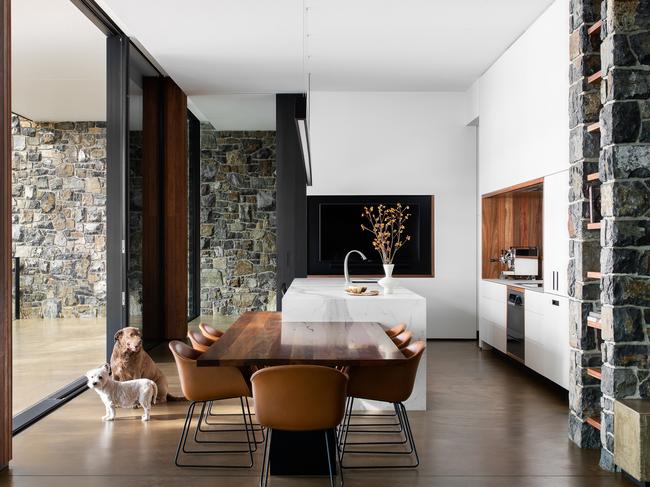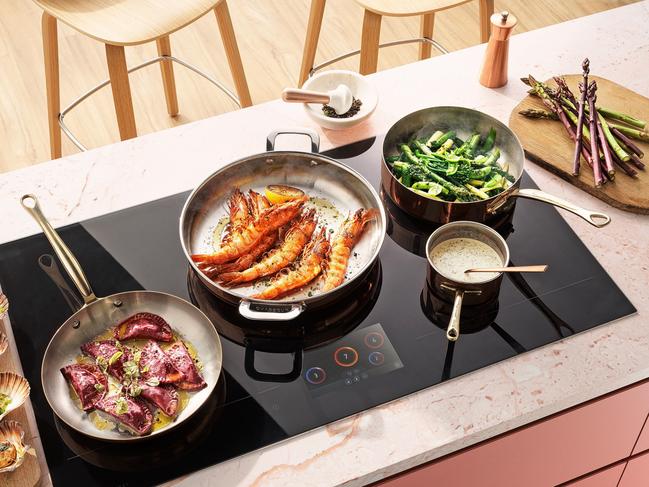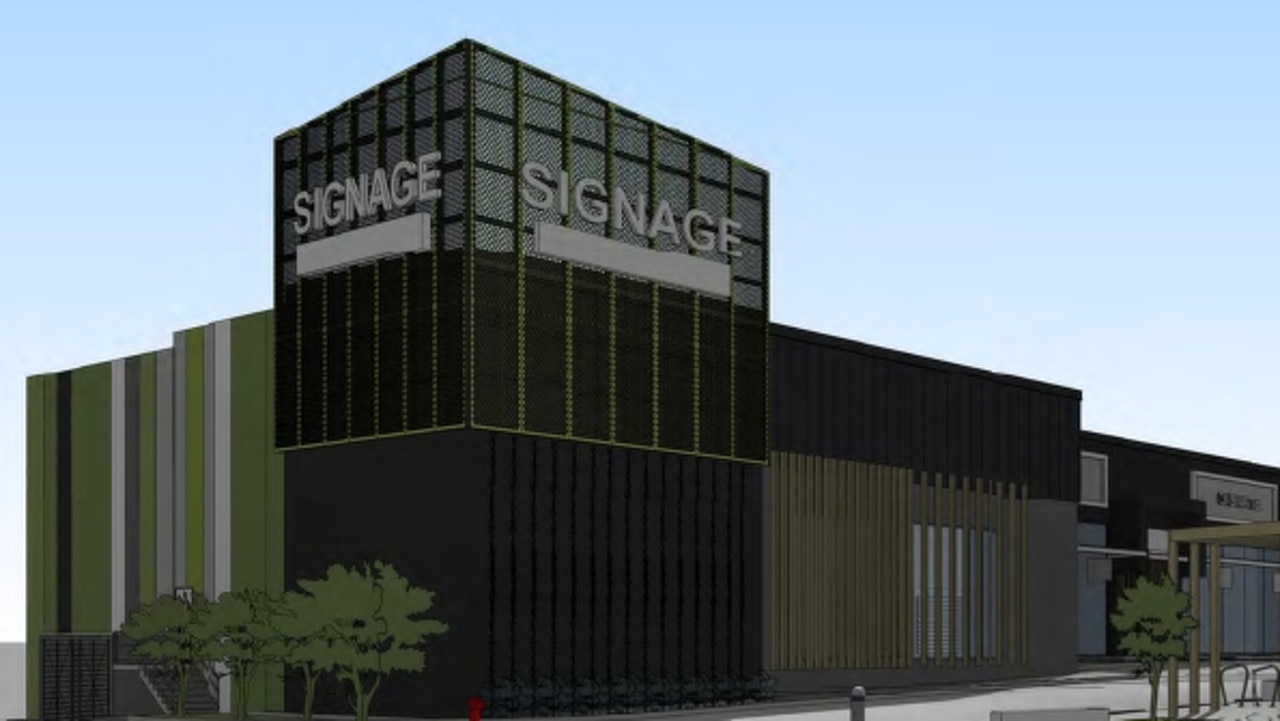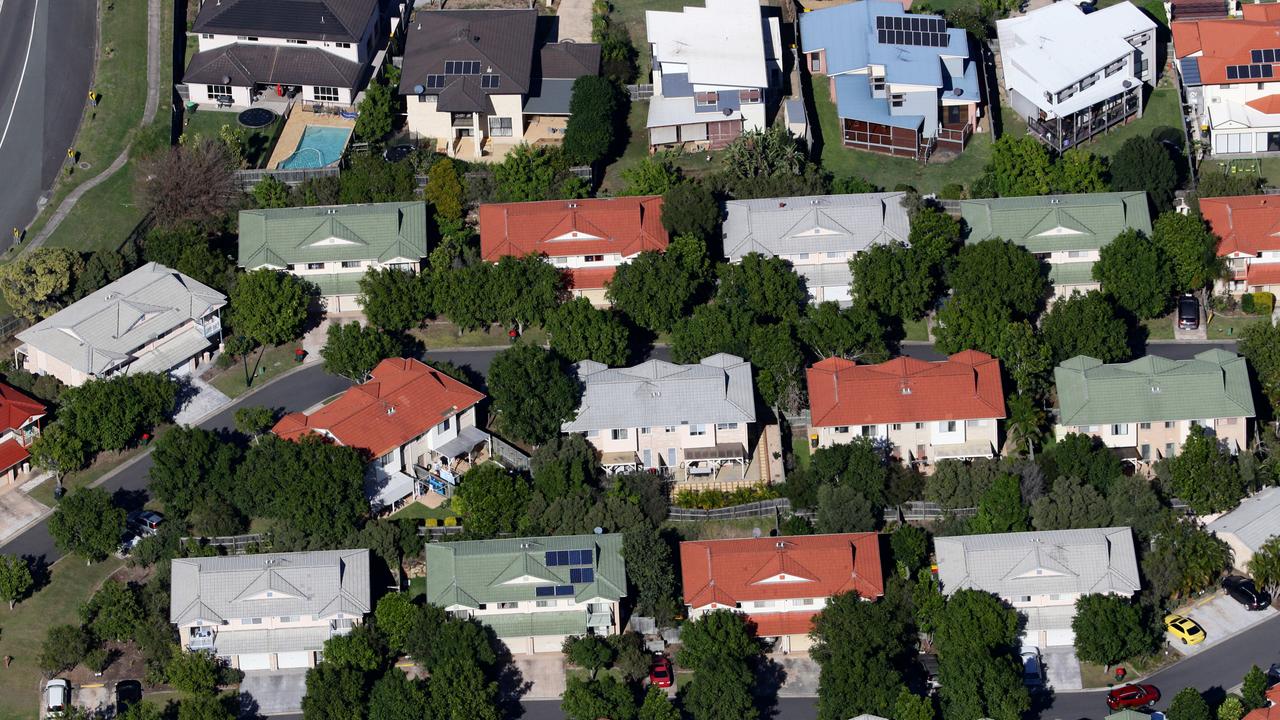Innovative kitchen trends of 2023 include ‘self healing’ cabinets and pull out step stools
Once upon a time stepping on a kitchen draw to get a boost up was a bad idea. Now, it’s something designers are embracing as they ramp up innovation and functionality with style.

Property
Don't miss out on the headlines from Property. Followed categories will be added to My News.
From gas to induction and stainless steel to black glass – these are the trends shaping Australian kitchens in 2023.
We’ve compiled the looks and functions trending across cabinetry, splashbacks, storage, lighting, cooktops and appliances as well as some clever new innovations that are set to add extra wow factor when it comes to dinner time.
‘SELF-HEALING’ CABINETS
Shiny cabinets are giving way to textural treats – which are easy-to- clean, of course.
“Smooth and finger-resistant laminates are on trend,” says John Hall of Nobby Kitchens.
“They feel magic to the touch and are easily kept clean with their fingerprint-resistant technology. They are also very affordable and look amazing.”
“We are using matte laminate at the moment,” says architect Anne Hindley of Hindley & Co. “It heals itself after scratching – Fenix is our favourite.”

Texture comes to your cabinets in other ways, too, although at a cost.
“Shaker-style doors are a favourite, says Felicity Page, of Freedom Kitchens, listing three profiles: traditional, slimmer and a more contemporary option.
Decorative door/drawer inserts are another exciting trend, she adds.
“They elevate your kitchen – make them a feature within a run of joinery so as to not overpower. We offer fluted glass, perforated-metal designs and more. My favourite is Patina Mesh – it ages naturally and is so luxurious.”

‘SPENDY-SAVEY’ TILED SPLASHBACKS
For splashbacks, has the once-omnipresent subway tile caught the last train?
“We are seeing less of the subway,” says John Harrison of Kaboodle.
“Instead, we are seeing finger tiles in green, blue, burgundy and grey, as well as handmade ceramic tiles (pictured). They personalise a kitchen, making it warm and inviting.”
“One of our tricks is to cut a plain white 600 x 300mm tile in half to make 150 x 600mm, which we stagger, a subtle alternative to a subway,” says Anne Hindley.
“It’s a part of our spendy-savey approach – we use a beautiful expensive tile sparingly so it is appreciated, and team it with inexpensive cut white tiles, ensuring a smooth plane with a bit of texture.”

STORAGE WITH A FOOTSTEP
Storage is getting smarter, ensuring every corner count.
“Deep drawers, not cupboards, are the most popular solution,” says John Hall.
“Blum drawers provide full access to the joinery, soft-close and up to 70kg of storage.”
And, for tricky corners, Hafele Le Mans and Magic Corners come to the rescue.
“We use pullout pantries, drawers within pantries and corner carousels for full access,” says Page. Her fave at the moment is the Hafele Tandem Pantry.
“Installed within the cabinetry, and with adjustable shelves, it doubles your storage.”
But there are other innovations.
“In-built steps within drawers can carry a person’s full weight,” says architect Michael Nguyen, of Odyssey.
“So kids or shorter adults use the drawers as steps to reach shelving. Touch-to-open mechanisms are also more durable than in the past.”

STRIP TEASE LIGHTING
Sleek horizontal lighting strips over an island have taken the shine off the once-ubiquitous pendants lined up like the three stooges.
“Those pendants have always been a pet hate of mine,” says Hindley.
“We prefer can track lights or can lights over the island, and save pendants for dining areas so they do not compete.”
A mix and match of strip lighting, pendants and downlights (but not too many to avoid that runway look) will provide all the illumination you need.
Nyugen agrees: “We rarely propose three pendants over the island, opting instead for more practical lighting, such as a linear pendant or surface-mounted can lighting and a single pendant over the dining table.”

WILL GAS BE PHASED OUT?
Are gas cooktops taking their last gas-p?
“Gas is on a downward trend,” says Hall.
“Most customers are asking for induction, because it’s faster, more efficient and cheaper.” “There’s a huge trend from gas to electric, with customers opting for about 60 per cent induction, 30 per cent gas and 10 per cent electric,” says Paul Meirau, of Harvey Norman. “Electricity is cheaper and rumour has it, gas could be phased out after 2030.”

But induction requires more power, not always feasible in older homes.
That said, induction cooktops can run off a 10-amp power point, with power phasing – but you can only have one element on high.
Customers can have the best of both worlds.
“We advise a combo such as induction with one gas pod,” says interior designer Anna-Carin McNamara, “for people who love cooking with flame.”

APPLIANCES – WHAT’S HOT
Change is coming to the world of appliances as we know them. Here are some of the biggest differences:
■ There’s a switch from stainless steel to black glass for ovens, says Paul Meirau, of Harvey Norman. “We sell about 60 per cent black and 40 per cent stainless steel. It’s an overriding trend in Europe”.
■ The 60cm oven now comes in oven, grill, steam and microwave combos, says Meirau. “People don’t want to waste benchspace on a microwave. The steam function is what most people are asking for.”

■ Fridges are deeper and taller, but slimmer to save space, he says, with many only 800mm wide. Black is giving stainless steel a run for its money, with sales of each about 50-50. White? Forget it.
■ Smart dishwashers read the load and adjust temperature and water usage accordingly, says McNamara. “It’s just a shame they can’t unload themselves.”
■ Mini convective ovens, air fryers are “massive”, says Meirau. “People don’t want to replace ovens and they are easy to use. You can cook food straight from the freezer and it steams.”




